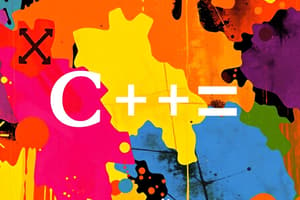Podcast
Questions and Answers
What is the objective of the CS304 course?
What is the objective of the CS304 course?
To familiarize students with the concepts of object-oriented programming and reinforce these concepts through implementation in C++.
What is Object Orientation?
What is Object Orientation?
Object Orientation is a programming technique that represents problems in terms of objects and their interactions, mirroring how things operate in real life.
Which of the following are examples of tangible objects? (Select all that apply)
Which of the following are examples of tangible objects? (Select all that apply)
- School (correct)
- House (correct)
- Ali (correct)
- Date
- Time
- Car (correct)
Object Orientation makes it easier to understand complex problems because it reflects real-world scenarios more closely.
Object Orientation makes it easier to understand complex problems because it reflects real-world scenarios more closely.
Every object in a system must have a specific role in its implementation.
Every object in a system must have a specific role in its implementation.
What is the main purpose of a model in programming?
What is the main purpose of a model in programming?
Flashcards
What is Object-Orientation?
What is Object-Orientation?
A programming technique that uses objects and their interactions to model real-world problems.
What are Objects?
What are Objects?
Objects are entities that have state (attributes) and behavior (operations) and a unique identity.
Tangible Objects
Tangible Objects
Objects that have a physical existence in the real world.
Intangible Objects
Intangible Objects
Signup and view all the flashcards
What is a Model?
What is a Model?
Signup and view all the flashcards
Object-Oriented Models
Object-Oriented Models
Signup and view all the flashcards
Advantages of Object-Orientation
Advantages of Object-Orientation
Signup and view all the flashcards
What are Attributes?
What are Attributes?
Signup and view all the flashcards
What are Operations?
What are Operations?
Signup and view all the flashcards
Unique Identity
Unique Identity
Signup and view all the flashcards
The Purpose of Modeling in Programming
The Purpose of Modeling in Programming
Signup and view all the flashcards
How are Objects Similar to Real-World Objects?
How are Objects Similar to Real-World Objects?
Signup and view all the flashcards
Study Notes
Object Oriented Programming (CS304) Handouts
- This document is a set of handouts for a course on Object-Oriented Programming (CS304).
- The document covers various lectures, ranging from introduction to more advanced topics.
- It includes specifications of various lectures and examples.
- Last updated on 20/08/2009 for the Virtual University of Pakistan.
Course Objectives
- The course aims to familiarize students with object-oriented programming concepts.
- Concepts will be reinforced through C++ implementations.
Course Contents
- The course covers various topics, including:
- Object Orientation
- Objects and Classes
- Overloading
- Inheritance
- Polymorphism
- Generic Programming
- Exception Handling
- Design Patterns
Recommended Textbook
- C++ How to Program (Deitel & Deitel)
Reference Books
- Object-Oriented Software Engineering by Jacobson, Christerson, Jonsson, Overgaard
- The C++ Programming Language by Bjarne Stroustrup
What is Object Orientation (OO)?
- A technique to visualize programming problems like real-life objects.
- Objects interact and perform operations.
- Examples: A person, a house, a tree, a car. (in diagrams)
- Objects interact to perform operations in diagrams. e.g., Ali driving a car
- Other example: A school with student, teacher, books, pen, etc
What is a Model?
- An abstraction of a real or conceptual thing.
- Models help understand a part of reality.
Object-Oriented Models (OO Models)
- Used to understand problems before writing code
- Show interacting objects in real life scenarios (diagrams).
What is an Object?
- Tangible or conceptual entities.
- Ali, Car, House, Tree are examples of tangible objects.
- Have a state (attributes) and behavior (operations)
- e.g., Ali (name, age) - walks, eats
- e.g., Car (color, model) - accelerate, start car, change gear
- Unique identifiers.
Tangible and Intangible Objects
- Tangible: Ali, School, House, Car.
- Intangible/Conceptual: Time, Date.
Object-Oriented Advantages
- Easy to understand and develop object-oriented models.
- Easy implementation with OO languages (e.g., C++).
- Mapping problems to real-life structures.
Studying That Suits You
Use AI to generate personalized quizzes and flashcards to suit your learning preferences.




